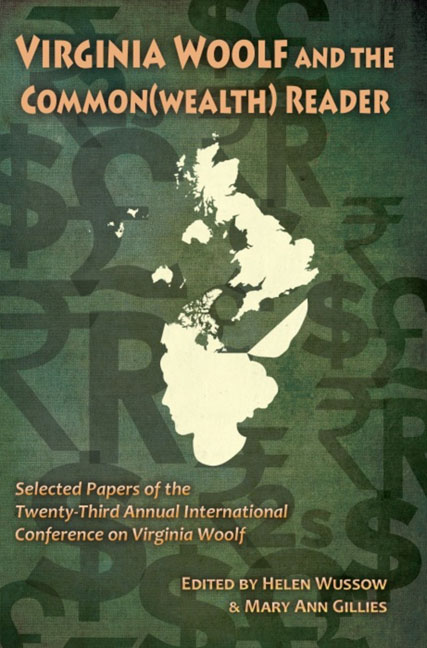Book contents
- Frontmatter
- Contents
- Introduction to Virginia Woolf and the Common(wealth) Reader
- Acknowledgments
- List of Abbreviations
- Invocations
- Networks of Affiliation: Foundations and Friends
- Woolf and the Commonwealth
- “Simplicity and art shades reign supreme”: Costume, Collectibles, and Aspiration in Katherine Mansfield's New Zealand
- Wealth in Common: Gifts, Desire, and Colonial Commodities in Woolf and Mansfield
- On a View from the Rims: Katherine Mansfield and Emily Carr
- London Calling: Una Marson in the Colonial London Scene
- Modernism Across the Commonwealth: Virginia Woolf's and Arundhati Roy's Critique of Empire
- From Bloomsbury to Fountain Lakes: An Australian Virginia Woolf
- 1930s Onwards
- Woolf Beyond the Book
- Notes on Contributors
- Conference Program
“Simplicity and art shades reign supreme”: Costume, Collectibles, and Aspiration in Katherine Mansfield's New Zealand
from Woolf and the Commonwealth
- Frontmatter
- Contents
- Introduction to Virginia Woolf and the Common(wealth) Reader
- Acknowledgments
- List of Abbreviations
- Invocations
- Networks of Affiliation: Foundations and Friends
- Woolf and the Commonwealth
- “Simplicity and art shades reign supreme”: Costume, Collectibles, and Aspiration in Katherine Mansfield's New Zealand
- Wealth in Common: Gifts, Desire, and Colonial Commodities in Woolf and Mansfield
- On a View from the Rims: Katherine Mansfield and Emily Carr
- London Calling: Una Marson in the Colonial London Scene
- Modernism Across the Commonwealth: Virginia Woolf's and Arundhati Roy's Critique of Empire
- From Bloomsbury to Fountain Lakes: An Australian Virginia Woolf
- 1930s Onwards
- Woolf Beyond the Book
- Notes on Contributors
- Conference Program
Summary
On June 19, 1908 in Wellington, New Zealand, Katherine Mansfield—Kathleen Beauchamp as she then was—wrote to her sister Vera. It was a momentous day on which she had received final confirmation that she would be returning to London. Her family were out and her delight quickly shifted to a more essential and fundamental problem she wished to share with her sister—what to wear:
I've nothing fashionable at all—simplicity and art shades reign supreme—A black flop hat with a wide wreath of mauve chrysanthemums round the crown— a little evening frock of satin—soft satin—made exactly after the pattern of Grandmother Dyer's wedding dress—a green straw Home Journal travelling hat with wide black wings—and everything in like manner—Chad & Mother have been yearning, I know to blossom into empire frocks and créations de la moment— but I haven't one—clothes ought to be a joy to the artistic eye—a silent reflex of the soul—so I'm training my amenable little soul accordingly. (Letters I: 49)
Costume and performance are concepts that easily attach to Mansfield's career and to her fictional characters: as Raoul in her 1918 story “Je ne parle pas français” says:
How can one look the part and not be the part? Or be the part and not look it? Isn't looking—being? Or being—looking? (Stories 288)
The display of multiple invented selves that is a hallmark of modernism is a recurrent signature in Mansfield's writing: “True to oneself!” she writes in 1920:
Which self? Which of my many—well, really, that's what it looks like coming to—hundreds of selves. For what with complexes and suppressions, and reactions and vibrations and reflections—there are moments when I feel I am nothing but the small clerk of some hotel without a proprietor who has all his work cut out to enter the names and hand the keys to the willful guests. (Notebooks II: 204)
This stance—seemingly literary and personal—is also connected to, indeed, grows out of the conscious, contrived display of self and style that was a feature of the society she came from: colonial yet urban…
- Type
- Chapter
- Information
- Virginia Woolf and the Common(wealth) Reader , pp. 78 - 87Publisher: Liverpool University PressPrint publication year: 2014

